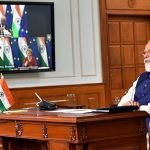
Golden opportunity awaits India in Golden Triangle
During these difficult Covid-19 times, the Latin American and Caribbean countries would look to source affordable products and services. This provides India with an opportunity and access to the market of these distant countries and also help the latter reduce their dependence on China.
Traditionally, India’s engagement with Latin American countries has been according to the Non-Aligned Movement (NAM), apart from being facilitated by the ‘Global South’, which still has some resonance in Latin America. India till now has not utilised the full potential of being a trade and FDI partner for Latin American and Caribbean (LAC) countries. India’s relationship with the US has improved in the last few years and now, even more with the latest India-China trade rift. The LAC countries have been a trade and investment ally of the US for several years. Given the LAC-US agreements, India can make a headway in both the markets by establishing diplomatic relations with people on the ground in these countries. During these difficult and sensitive times, the LAC would look to source affordable and inexpensive products and services. This provides India with a huge opportunity and access to the LAC market and LAC to reduce its dependability on China. This is a moment for India to strengthen the relationship and take an advantage of golden triangle.
LAC has trade relations with a few countries in Europe and South Africa. This is what can be defined as a Golden Triangle. The European Parliament passed the EU-Latin America Trade resolution on 13 September 2017. The EU has concluded association with 27 of the 33 countries in the LAC region. Mexico and South Africa signed a series of economic agreements in 2014. Several free trade agreements are already in place, including an agreement between MERCOSUR (South American trade bloc comprising of Argentina, Brazil, Paraguay, Uruguay, and Venezuela) and the South African Customs Union.
In the Golden Triangle, enterprises can save import-export taxes, stock inventory and streamline their supply chains effectively. For example; enterprises with customer base in South America, Africa and Europe can make use of the custom bonded warehouses on the ports in South America as their inventory to reduce the lead time. Distribution to North America is extremely viable using Panama and Mexico.
The LAC market consists of 19 countries, with a population of 620 million and a combined GDP of about $6 trillion. The six major economies — Argentina, Brazil, Mexico, Colombia, Chile and Peru — account for 85.2% of the total of the Latin America and the Caribbean (LAC) economic activity. Brazil is the largest market with over $2 trillion of GDP and a member of BRICS, Mexico is second, with close to $2 trillion GDP and the largest trading nation.
Economic developments in Latin America have been strongly influential since the beginning of the year due to the spread of Covid-19. Latin America’s exports and imports of goods are estimated to have fallen in value by 17% and 18%, respectively in the first half of 2020, according to the August report of the Economic Commission for Latin America and the Caribbean (ECLAC).
India lags behind in terms of absolute volume of trade with LAC as compared to the EU and the US. India’s exports to Latin America increased by 9.6% in 2018-19 (April to March) reaching $13.16 billion. India’s exports to the US stood at $35.73 billion in 2018-19 and the EU at $57.20 billion in 2018-19.
Indian companies, including NRI firms, have invested about $12 billion in the region in varied sectors. India’s IT and ITenabled services industry has been a pivot in India’s outward expansion which has benefited Latin America. Indian IT & ITES companies like TCS, Infosys, Wipro, KPIT Cummins between them employ almost 20,000 Latin Americans.
United Phosphorus Limited is one of the leading agrochemicals and seed company and has a turnover of $1.2 billion with plants in Brazil, Argentina and Colombia. Novelis has Aluminum and carbon black plants in Brazil with an annual turnover of $2 billion.
Mothersons Group has over a dozen plants in Mexico and Brazil, generating 9.2 % of its global revenue, about $1 billion. The annual revenue of the Indian manufacturing companies in Latin America is estimated to be around $4 billion.
India has signed several agreements with a few countries in the LAC. The SICA-India agreement prioritised agriculture, SMEs, pharmaceuticals, tourism, IT-related activities, renewable energy, among others. In 2019, India signed a nuclear agreement with Argentina, which is assisting New Delhi in setting up small nuclear plants in India. A steady expansion of state visits in both directions (Luiz Lula, the former Brazilian President, visited India three times in eight years) gave the right signals to the private sector, which followed through in a variety of areas.
The Brazilian President’s visit to India in January 2020 further boosted India’s forays into Latin America. The visit was strengthened with 15 agreements and a Memorandum of Understanding (MoU) including Investment Cooperation and Facilitation Treaty, Mutual Legal Assistance in Criminal Matters, Bioenergy and Cyber Security.
Also, culturally, LAC has small pockets of Indian diaspora (Hindus) across the region. There are about 550,000 Hindus in South America, 270,000 Hindus in Guyana, 120,000 in Suriname, and some others in French Guiana. The region is influenced by yoga, Bollywood movies and cricket. Dhoom 2, Kites, reality TV show Khataron ke Khiladi was shot in Rio De Janeiro and Santa Fe, Mexico. Rajnikanth and Aishwarya Rai dance sequence for the film Robot was also shot in Machu Pichu (in Peru). Argentina has been the strongest cricketing nation in South America, with a history of over 200 years and there are multiple cricket championships which take place in Lima, Argentina and Suriname.
Latin America is becoming a significant source of natural resources for India — oil, copper, soya and iron ore, among others, which calls for a stronger policy. India’s steady, opening to the world economy, its high savings and investment rate, and rapidly expanding middle class, whose demands for Western consumer products is growing in leaps and bounds, offer enormous trade opportunities. A combination of government initiatives and private ventures should open up new vistas in IndiaLAC trade and investment, leading to an eightfold expansion in interregional trade. The Indian government should focus on a shared economy model and promote MSMEs, corporates and startups in both the countries. Also, investment in shipping industries and concluding PTAs (Preferential Trade Agreements) and FTAs (Free Trade Agreements) is the need of the hour. Most importantly, it should remove the barriers that have held back the India-LAC relationship which can achieve its full potential.
Rajesh Mehta is a Leading International Consultant & Policy Professional. Prathamesh Karmarkar is an economic development expert, having worked with various national and provincial governments in India, Americas, Europe and the Middle East.



